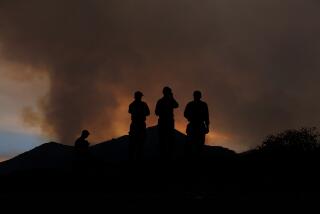Firefighters Dig In at Mount Baldy Village
- Share via
A weather system hovering off the coast sent a thick fog layer Thursday over the Angeles National Forest, providing relief to the foothill communities of the San Gabriel Mountains that had been threatened this week by fire.
But higher in the forest, the 5-day-old fire continued to move toward Mount Baldy Village, where firefighters were preparing their defense late Thursday. Fire officials said that depending on temperatures, winds and humidity, the fire could arrive at the outskirts of the village late today or early Saturday.
The fire had grown to 32,000 acres and was 35% contained by late Thursday. Most of the containment was on the fire’s western and southern fronts, officials said. To the north and east, flames that have consumed 71 buildings continued to churn through heavy brush. The cost of fighting it had risen to $8.7 million.
As the fire approached Mount Baldy Village on Thursday from Cow Canyon to the west and Sunset Peak to the south, crews wielding chain saws worked to clear brush on the east side of Mount Baldy Road, underscoring fears that the blaze would breach the only road out of town.
“There are too many scenarios,” said San Bernardino County Fire Capt. Jim Wilkins, a spokesman for the dozens of agencies and 3,000 firefighters called to work this week. “The village is in imminent danger.”
The fire had closed to within a mile and a half of the village by nightfall. Firefighters had laid down 20,000 feet of hose throughout the village’s narrow, winding roads and trails; planes dove across ridges directly adjacent to town, painting the hills with red flame retardant.
Scores of Mount Baldy residents continued to defy an evacuation order, and tensions mounted Thursday between the holdouts and authorities.
“If you can get out, I can get out,” resident John Norris, 74, told Wilkins outside the Mount Baldy post office, which has become a gathering place since the fire began closing in. “If you die, I die.”
“I wish you the best,” Wilkins replied. “I really do.”
One firefighter said he described to residents what could happen to anyone caught in a forest fire. Smoke inhalation, he said, not flames, typically brings death, and that could take can take as long as 10 agonizing days.
One group of holdouts included a 90-year-old woman who uses a walker. Her relatives refused to take her down the mountain to safety because they would not be allowed back up to defend their homes.
Officials went door-to-door on another sweep of homes Thursday afternoon, pleading one last time for residents to leave.
“You can drag my smoldering carcass out of here,” said Michelle Olson, an 11-year resident of Mount Baldy, whose family owns a nearby ski resort. “Short of that, I’m staying.”
Officials ordered the evacuation of Mount Baldy on Tuesday night, but as many as 100 of the town’s estimated 900 residents remained Thursday.
“We can’t physically remove people from their homes,” said Craig Walker, a Twentynine Palms firefighter and chaplain. “If you really want to stay, there is nothing we can do.”
Wilkins said even old-timers in Mount Baldy who have survived past wildfires do not understand the implications of staying if the blaze hits the town.
“It will happen with an intensity and ferocity that rivals any force of nature in the world,” he said. “I don’t know if these people get it. God bless ‘em. May God watch over them.”
At least six firefighters have been injured, including one who received first-degree burns on his face, one who suffered an ankle injury and one who was swarmed by bees. The injuries were not life-threatening, officials said.
The blaze began Sunday, and has been dubbed the Williams fire, after a canyon, 25 miles north of Azusa, where it is believed to have started.
Investigators said they have ruled out campfires and barbecues as a source, but said Thursday that they are still unsure how it began.
Though the most violent flames are on the north and east flanks of the fire, another wall of flames had been advancing slowly toward the south, in the direction of Azusa, Glendora, San Dimas, La Verne and Claremont.
Officials said Thursday night that the threat to those cities was drastically reduced by the marine layer that settled in Thursday, as well as the work of firefighters.
Residents have been bringing firefighters blankets and roasted chicken. Many of the fire crews, which include volunteers, have been sleeping outside.
“We’ve never been treated better by a community,” firefighter Ken Rodriguez said near Glendora. “We’d like to come back here--but we don’t want them to have more fires.”
A gold prospector who lives at Camp Follows along the east fork of the San Gabriel River said he was the first person to report the fire on Sunday. Bernie McGrath, 62, said it appeared to start about 150 yards from Camp Williams.
“I’d finished dredging in the river, and I was taking a rest at about 3 or 4 o’clock, when I looked up and saw a big billow of smoke,” McGrath said. “I called the volunteer fire department at Camp Follows on my radio, and then I got in my truck and drove down there.
“There weren’t any cars parked there and there weren’t any barbecues or anything like that, so I don’t know how it started.”
*
Times staff writers Jose Cardenas, Geoffrey Mohan and Kenneth Reich contributed to this report.
More to Read
Sign up for Essential California
The most important California stories and recommendations in your inbox every morning.
You may occasionally receive promotional content from the Los Angeles Times.














